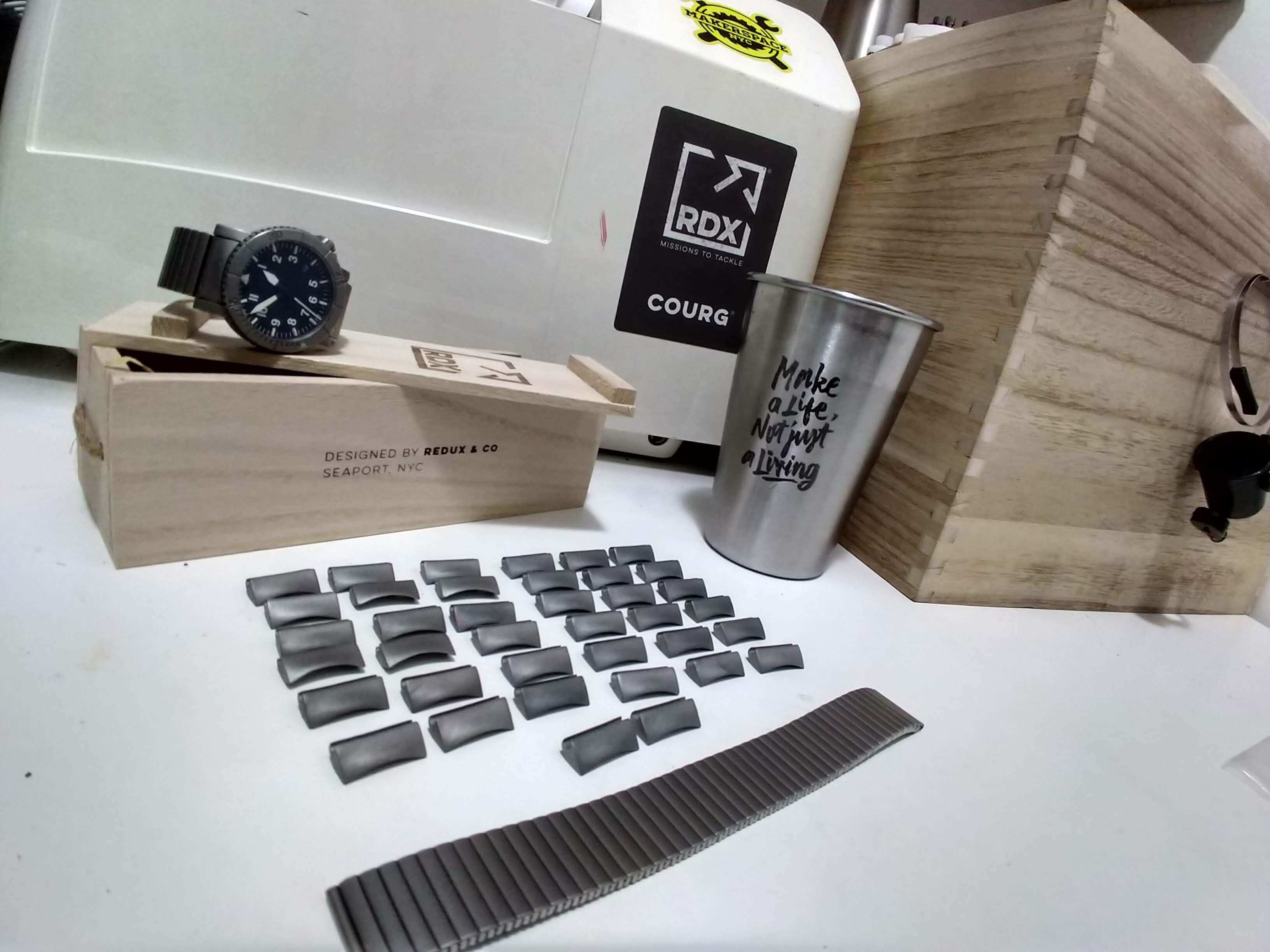“Every new beginning comes from some other beginning’s end.”
A quitter’s manifesto for non-quitters, join me?
I quit thinking managing better is the answer.
I quit trying to make it all cram into one day.
I quit having my attention pulled in too many directions.
I quit others’ priorities.
I quit a constant drip of emails and Slack messages.
I quit the excuses that a salary wraps a comfy blanket around inertia.
I quit being dragged here and there by the tyranny of the urgent, rather than driving at the important.
I quit feeling cranky and dismissive of my kiddos, and my Wonderwoman.
I quit the blur.
And here’s my why.
What’s yours?
“Every new beginning comes from some other beginning’s end.”
And friends, it’s not just about quitting, it’s about going.
If you’re interested, here’s where we’re headed (and why).
… technically, I resigned. Friday was my last day at the day job.
I worked that day job for about 7.5 years, longer than Scout has walked the earth. The job began as a comfy pit stop.
The original idea, nearly 8 years ago, was to finish journalism school, then land for a year or so to pave the way for Scout’s arrival and our transition to a family of 3. Years later, we’re a family of 4+1 (we sometimes jokingly refer to Redux as our second child, born when Scout was a toddler).
I really did enjoy my job. I built things, made experiments, launched projects. I learned tons.
But I knew that job wasn’t where I was meant to be long term. Somehow the years crept, then blurred, and flew by.
For years my passwords were some iteration of “learn” and “go” with the current date. i.e. I was there to learn what I could, and then go, and the passwords were a constant reminder to myself. And every few months I’d update it and wonder why I was still there.
Resign sounds like defeat to me. Nope.
I quit.
There was no dramatic throwing of things across the room or yelling something and storming out the door. I just gave my 2 weeks. Thanked my team and appreciated an unexpectedly nice farewell on Zoom. And *POOF* a new start.
I quit thinking managing better was the answer.
I quit trying to make it all cram into one day.
I quit having my attention pulled in too many directions.
I quit an entire set of others’ priorities.
I quit a constant drip of emails and Slack messages.
I quit the excuses that a salary wraps a comfy blanket around inertia.
I quit being dragged here and there by the tyranny of the urgent, rather than driving at the important.
I quit feeling cranky and dismissive of Scout and Storm, not to mention Wonderwoman Grace.
I quit the blur.
Of course, this wasn’t some random impulse. The thought had germinated for years.
After we launched COURG via Kickstarter, one of my co-workers asked why I was still there, since I’d launched my own business. Big looking numbers can lead to big daydreams, apparently from others.
It was tempting to think I should have cut loose then and went all-in on Redux. I often wonder whether that would have been the right move.
But I know I wasn’t ready.
And now, 2020. It’s not that things have somehow become clearer. Quite the opposite.
Every time I send a newsletter out, I get a chorus of unsubscribes.
What did I say to annoy them? Maybe it was too long again. Maybe I made no sense.
But I’ve had to settle it in my mind and for my soul that maybe it’s just not the right fit for those people… at least not yet.
And maybe all they want is new watches and discounts.
I totally understand. I’m all for less emails, especially if they don’t add value for you right now.
It’s ok. No hard feelings.
And I also recognize that I’m not where I want to be on the level where I hope to equip and encourage you.
We have a vision for what we hope to build, but as far as the nitty gritty of how to get there, well that’s being worked out.
And I feel it requires my full focus.
We decided to take a six month runway and see where it leads.
I certainly don’t have it figured out.
But I’m not going to let that stop me from exploring and pushing out into the deep. Because that’s all I can do.
I’m quitting from the shallows. I’m quitting from clinging to the shore.
A couple years ago I felt the words, “Let us go over to the other side” resound deeply in my soul. In every fiber of my being.
I still have no idea exactly what that means, but I’ve been working it out, and I’m thankful to be on the way.
I know that the “other side” isn’t just some meta meaning, just some way of thinking.
We began to shove off shore in many ways.
Finding footholds to make a start.
I knew deep down that the Other Side meant a radical upside-down stomach lurching change. Less evolution and more revolution.
I’ve seen the horizon of the Other Side in my own work in spirit, soul and body. I feel more at peace than I ever have in my life.
I’ve glimpsed the other side in my marriage in the most profound and meaningful way with Wonderwoman grace.
I’ve glimpsed the joy and fulfillment of being present with the littles.
And I’m not shy about my faith because I feel closer to Jesus than ever before.
We started 2020 with ideas that it was meant to be a year of big change. We would run a Kickstarter. We hoped we would find confirmation that COURG was not a one hit wonder. And with that assurance we would leave the day job.
Well, that’s not how it worked out. And I’m thankful.
Thankful that I’m leaving for the most important and right reasons.
Thankful that in the end it was our call and not something that just happened to us — even if a severance package would have been nice to have.
I’m brutally aware that this is all probably too much information.
But I’m risking the overshare because I figure if I can just open up my soul a bit and show up, maybe it’ll help someone. Maybe someone will be encouraged.
To quit.
Doesn’t have to be your day job (unless you should).
Of course the follow-up question I’m repeatedly asked is: “Where are you going? What’s your new job?” As in, assuredly you have another job lined up already?
Well, yes. Just maybe not in the obvious way.
It’s not just about quitting, it’s about going.
Going to hit hard reset.
Going to learn how to homeschool Scout. Too many hours staring at a screen remotely learning. Remote in every sense. Scout asked to be homeschooled since even before the lockdown. It’s time.
Going to focus on serving you all better.
Going to start a new chapter.
Going to the Other Side.
Who’s with me?
Here’s your heads up display.
by Amy Hodges
No matter how much you do it, practice may never make you an expert. But it probably will make you better.
“This question is the subject of a long-running debate in psychology,” says Fred Oswald, professor and chair of psychology at Rice University. “Why do so few people who are involved in sports such as golf, musical instruments such as the violin, or careers such as law or medicine ever reach an expert level of performance?”
For a new study published in Psychological Science, Oswald and colleagues reviewed 88 previous studies (more than 11,135 total participants) published through 2014 that investigated relevant research on practice predicting performance in music, games, sports, educational, and occupational domains.
Within each domain, the researchers averaged the reported results across all relevant studies and found that “deliberate practice”—defined as engagement in structured activities created specifically to improve performance in a specific field—explained 26 percent of the variance in performance for games, 21 percent for music, 18 percent for sports, 4 percent for education, and less than 1 percent for professions.
“Deliberate practice was a strong overall predictor of success in many performance domains, and not surprisingly, people who report practicing a lot generally tend to perform at a higher level than people who practice less,” Oswald says.
“However, perhaps the more important contribution of our study is that no matter how strongly practice predicted performance in our findings, there was always statistical room for other personal factors to predict learning a skill and performing successfully, including basic abilities.”
Significant amounts of research have already identified basic abilities as also being important to predicting performance, but some researchers tend to minimize them and consider practice as the sole determinant of performance.
“Other factors matter as well, but even so, no one says that practice will ever hurt you; but be careful if you are walking tightropes.”
Rice University, Princeton University, and Michigan State University funded the original study.
A version of this article first appeared on Futurity.
No matter what, storms leaves wreckage and loss. What can be shaken must flex — or break.
And yet on the other side of a storm … all things are new.
We’re not through this storm yet, but we decide how we’ll navigate trauma.
We’ve all heard of PTSD (post-traumatic stress disorder).
But there’s an opposite. Post-traumatic growth.
Transforming trauma to growth. Resilience.
I didn’t make that up. It’s when you emerge from trauma, shaken but unbroken.
Clarified. Focused. Lessons learned.
The little reed, bending to the force of the wind, soon stood upright again when the storm had passed over.
Sometimes (often) I get stuck in a project muddle. Especially during the year of massive delays.
A new watch design or project idea lights me up and I dig deep.
It’s almost like a fever. Consuming. Obsession.
But sometimes that fire loses some fuel as I wrangle watch design details or wrestle with manufacturers that say, “That’s impossible.”
From mountain highs of vision to valleys deep in drudgery.
Many hundreds of decisions that chip away at resolve.
For example, here’s tiny details on COURG/42. And this is just one round out of months of revisions.
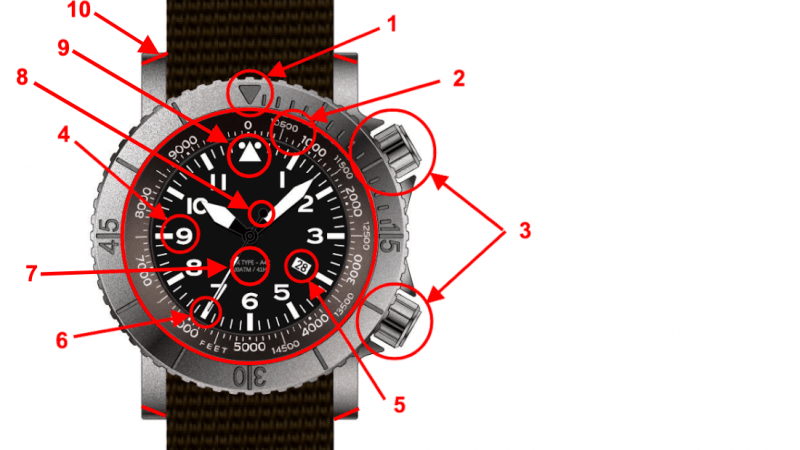
I think it’s similar to when I haven’t picked up my ukulele for weeks.
A big reason is because I’ve gotten bored with the songs I know.
I’m no longer playing. I’m just going through the motions.
We all need the new song spark.
Exploring. Stretching. Trying new things.
Because nestled amid the awkward, stiff, twisted fingers of learning a new song — there’s a special moment.
A click. The notes start to ring clear. Then the rhythm springs to life.
When the sounds become the shape of a song.
When I start to feel the music, or maybe it’s the music filling me.
It’s flow state in the stream of melody and it’s a taste of rapture.
Intoxicating — not in a drunken sort of blurry way. A kind of clarifying potion.
And then I return to what muddled me before with renewed vigor and fresh insight.
A heightened state of awareness — even appreciation for a project to pick up and work through.
Whatever way you make your music — designing watches, restoring cars, writing code, serving your community, loving your family, flying planes, teaching kids, healing people, building a business …
Don’t let boredom lull you to sleep so you forget to learn new songs.
Play when the first few notes sound discordant.
Play when your fingers feel like sticks.
Play when the melody sounds alien.
Play when it feels like it’s been too long — sometimes that’s exactly when you’re really ready to get back to work.
And remember these words of wisdom from someone who knew a little something about deep work:
Play is the highest form of research.
The flow will come. You’ll find new work, new solutions also bring new insight into previous muddles.
Often when you least expect it.
Keep on making your music.
Play on.
And people might laugh. They might hate it. They might fall asleep. They might run. They might misunderstand.
Those who matter will get it. They’re the ones who matter.
And they’ll thank you for showing up and playing your music.
Don’t give up. Give it away.
A project from my cabinet of curiosities.
Meet Fuente Fuente OpusX Belicoso.
A cigar box ukulele I made during lockdown.
For the brave: Full origin and build story.
When I first learned to play my new ukulele, my fingers hurt. They turned an angry red. They ached.
The notes sounded horrible.
In time the pain receded and music ascended.
Through a long year, suffering produces callouses in our lives.
We harden. The shell thickens to dull the onslaught.
But we have to be careful that we don’t allow that layer to get too thick.
Or we won’t feel a thing. And worse — we’ll lack compassion.
It takes time to process and let your soul catch up with all that’s happened and changed.
It’s the callouses that enable us to press into the pain.
Because we’ve been there. We’re willing to push in.
Because even if we can’t see it, we know deep down suffering can become glory, and glory is a beacon.
And that requires time and space to heal and recover.
When we press into the pain that has healed, we make musical notes that resonate with others who bear the same pain.
Sometimes, we think of callouses as a bad thing.
Ugly. Rough. Coarse.
The mechanic or carpenter with tough scaly hands. Yet what wonders they craft with their hands — which have been formed by the work they’ve practiced repeatedly.
They become so practiced they could do their craft with their eyes closed.
Sometimes before bed, I dim the lights and strum my ukulele to decompress.
At first I had to squint down at my fingers. But after a few weeks I realized I didn’t even need to look down at the strings anymore.
Our practice shapes our lives to the best form to serve others. Our work makes something, and at the same time the work shapes us. It builds muscle memory in our lives so we can build others up.
But it takes time. Reflection. Being willing to stay in the dark. Sit and learn from the pain.
To be unashamed of the scars.
And even when we can’t see, even when things are dark and uncertain, because of our practice, we will know which notes we need to play in the night — for ourselves and for others.

Want to make your own? Here’s how I made mine.
What’s your most recent win?
What invigorates you every morning?
Sometimes it’s tough to crack that sheet of ice that chills our souls in sleep.
For some it’s a sweat. Working out, running, HIIT. Caffeine.
We pay attention to our bodies and that’s certainly a good start.
But what about your mind and emotions? How do you kickstart that in a meaningful way?
A life of abundance is awareness and attention. Not rushing here. There. Everywhere.
Not when we’re clamoring, clawing for something else.
Glass half empty? Or half full?
Neither. It’s enough.
Go for a gratitude workout.
When practiced correctly gratitude is guaranteed to level up your life.
It’ll take less time than your workout, heck you can even incorporate the mindset shift into your physical workout.
Here’s 3 simple experiments to try today. Continue reading →
A research team studying the positive effects of daily gratitude says it can change people’s lives—but it takes mental toughness and discipline.
The payoff, however, can be significant.
Compared with those who dwell on daily hassles, people who take time instead to record their reasons for giving thanks exercise more regularly, complain of fewer illness symptoms, and feel better about their lives overall. They also feel more loving, forgiving, joyful, enthusiastic, and optimistic about their futures, while their family and friends report that they seem happier and are more pleasant to be around. Continue reading →
I hope you voted (if you’re in the U.S.). I did.
But I don’t care if you voted Trump or Biden or other.
I don’t care if you’re Republican or Democrat or neither.
What matters is we’re in this together and we all want a brighter future.
Better than yesterday. Bickering won’t get us there.
Watching the news won’t get you there.
Let’s vote for an epic today and an amazing tomorrow.
Not by what we say, but by what we do and how we live.
That was then. This is now. Uncertainty will pass when you focus on what is certain.
What is certain is you have a purpose to fulfill today.
Good work to do. A family to lead. Problems to solve. Wounds to heal.
Let’s go.
TL;DR:
Over the many months of lockdown, I found some gear super useful.
Now, with a surge of cases expected going into the fall and winter, I thought it might be helpful to share what I’ve found. Just some recommendations for some gear I’ve found indispensable, and you may find useful too.
There’s some other gear that I’ve put to use over this year, but those are things I made for myself. I’ll share them soon as experiments or part of opening up my cabinet of curiosities.
What follows below are items that have been a great help straight off the shelf.
(I think you know this by now, but in case you don’t it bears repeating: I don’t accept pay to play. I only recommend good stuff I use myself and have proven worth in my kit. If you purchase from affiliate links, we might get a clink in the tip jar. Thanks if you do!)
TL;DR:
Transformation doesn’t just happen while we sleep. Everyday we must choose to grow.
We must start, but we can’t rush.
Science provides suggestions for how to install upgrades. Not everything works for everyone, but finding out what does work is the work.
TL;DR:
But if you want more, you can always keep reading. Continue reading →
New research indicates that our cognitive capacity is reduced whenever our phones are within reach—whether it’s turned on or off.
Adrian Ward and coauthors conducted experiments with nearly 800 smartphone users in an attempt to measure, for the first time, how well people can complete tasks when they have their smartphones nearby, even when they’re not using them.
In one experiment, the researchers asked study participants to sit at a computer and take a series of tests that required full concentration in order to score well. The tests were geared to measure participants’ available cognitive capacity—that is, the brain’s ability to hold and process data at any given time.
Before beginning, participants were randomly instructed to place their smartphones either on the desk face down, in their pocket or personal bag, or in another room. All participants were instructed to turn their phones to silent.
The researchers found that participants with their phones in another room significantly outperformed those with their phones on the desk, and they also slightly outperformed those participants who had kept their phones in a pocket or bag.
The findings suggest that the mere presence of one’s smartphone reduces available cognitive capacity and impairs cognitive functioning, even though people feel they’re giving their full attention and focus to the task at hand.
“We see a linear trend that suggests that as the smartphone becomes more noticeable, participants’ available cognitive capacity decreases,” says Ward, an assistant professor at McCombs School of Business at the University of Texas at Austin.
“Your conscious mind isn’t thinking about your smartphone, but that process—the process of requiring yourself to not think about something—uses up some of your limited cognitive resources. It’s a brain drain,” Ward says.
In another experiment, researchers looked at how a person’s self-reported smartphone dependence—or how strongly a person feels he or she needs to have a smartphone in order to get through a typical day—affected cognitive capacity.
Participants performed the same series of computer-based tests as the first group and were randomly assigned to keep their smartphones either in sight on the desk face up, in a pocket or bag, or in another room. In this experiment, some participants were also instructed to turn off their phones.
The researchers found that participants who were the most dependent on their smartphones performed worse compared with their less-dependent peers, but only when they kept their smartphones on the desk or in their pocket or bag.
Ward and his colleagues also found that it didn’t matter whether a person’s smartphone was turned on or off, or whether it was lying face up or face down on a desk. Having a smartphone within sight or within easy reach reduces a person’s ability to focus and perform tasks because part of their brain is actively working to not pick up or use the phone.
“It’s not that participants were distracted because they were getting notifications on their phones,” says Ward. “The mere presence of their smartphone was enough to reduce their cognitive capacity.”
Source: University of Texas at Austin. Original Study This piece was originally published on Futurity.
A family favorite.
We tried this after I picked up a store made batch and Wonderwoman Grace thought she could do better. She was right.
These are amazing.
(I feel slightly ridiculous offering you a recipe, but it’s way too good not to share, and I’d feel like a totally bad friend if I didn’t at least give you the opportunity to try these with your family. Also, Wonderwoman Grace tells me they’re crazy easy to make. So, don’t say I never shared good stuff with you. I promise I won’t do it too often haha!)
We modified it a bit from the original to reduce sugar and make it more crispy, crunchy on the outside.
(H/T Taste of Home)
Let’s START something new.
Redux exists to equip and encourage you to tackle your missions. I just happened to start with hardware — watches.
Now, I’m starting an experiment to be more intentional about ground support for your wetware (mind, soul, spirit, character) upgrades.
Once a week I’ll debrief with you on three waypoints (like trail markers) converging on one theme.
Why three?
Well, it takes three points to triangulate your position. When you connect the dots, and remember where you’re headed, you can course correct as needed.
Weekly Waypoints will include:
Everything you need will be in the email, think of it as a heads up display. But if you want more, you can always meet me here the jump for a dive deep.
This week, in honor of this humble launch, let’s START SMALL.
It’s been an insane year. Many people are waiting for 2021 to make things better.
<Breaking News>
There’s no point in waiting for January to get a new start. January 1 resolutions are pegged to an arbitrary date anyway. It’s only meaningful because we assign some magic to that date.
Any date will do. Today — right now — is as good a time as any, and certainly better than later.
“Start by doing what’s necessary; then do what’s possible; and suddenly you are doing the impossible.”
A Stanford behavior scientist wanted to do more pushups everyday. We all know exercise is a keystone habit that cascades into all kinds of goodness in our lives.
Most of us would just grit our teeth and do some until we “forgot” by day three.
Instead, Fogg picked an everyday trigger and started tiny. Every time he went to the bathroom, Fogg did ONE pushup.
Soon enough he could do more each pee break. He kept going and is up to 70 a day (depending on coffee intake haha).
“Take a behavior you want, make it tiny, find where it fits naturally in your life, and nurture its growth.
If you want to create long-term change, it’s best to start small.”
Make sure to celebrate small wins tangibly. i.e. *YES!* (queue: arm pump) because science confirms habits change through feeling good, not beating ourselves up.
What’s a goal or change you need to make? How can you start tiny and trigger it with something you already do every day? Write it down, START today!
TL;DR:
My 7 year old son, let’s call him Scout, looked up a word in the dictionary. On the way, he came across the word “ruby” with pictures of a gem before and after being cut.
Scout is obsessed with rocks.
Recently Scout saw a roughly polished opal of mine. He grabbed some generic rocks. He sanded. He painted. He coated them to look like my opal. He’s spent hours gently cracking geodes open.
Last week he said, “When I grow up, I’m going to be a geologist, and that’s my final answer.”
Needless to say, that ruby image hooked Scout.
After hours of research, Scout told me we needed to take a trip and he knew where to go and what to do. He even had a plan:
“How to find rubies, gold, and diamonds: Shovel with Knifes, Buckit, Hammer, Chesle”

Cue big eye roll (not a proud dad moment).
I felt the urge to say, “It’s not that easy. You have no idea how many people spend their lives trying to dig up treasure. Let’s be reasonable.”
And then I checked myself — we all need to START SMALL. The last thing he needs is me telling him what’s not possible, especially when I haven’t even tried.
Heck, I (probably) wouldn’t have launched Redux if I had known all the pitfalls and frustrations.
Sometimes, the not knowing — being unreasonable — is the only way we will go on the adventures we’re meant to explore.
So, instead I said, “Pack your chisel, kiddo, let’s plan a trip!” I’m not sure we’ll find anything, but I’ll let you know what we find.
What I AM certain of is that worst case no gems, but we might just dig up something far more precious — a treasure trove of good memories and the sparkle of exploration together.
On January 1st, I posted a message on Instagram about making 2020 epic. Little did I know… it’s been epic alright.
And now that we’re already barreling toward the end of 2020, I wanted to check in and debrief with you.
As some of you know, we planned to launch new watch design projects in 2020. Prototypes were originally scheduled to arrive last December. [Spoiler alert: We grounded those plans — actually that makes it sound almost pleasant and peaceful, it really feels more like a stomach lurching turbulence-induced stall.]
But then the world turned upside down. We hit massive delays from our industrial engineers and manufacturers.
Rest assured, we will push forward. Stay tuned for further intel next week.
In the meantime, I’m writing now for three reasons:
What’s that about curiosities? I have a bunch of projects in stealth mode. These have never seen the light of day for various reasons. Sometimes I just get distracted and need to make something. Other times these were experiments to find solutions for myself.
We’re down to our last watches! To be exact:
1 Type-A SOLD!
This is a huge milestone for us since we turned off all marketing and advertising a year ago with plans to transition into the new crowdfunding.
In the meantime, we received kind requests for specific variants not actually in stock. So, I’ve built them when I have the components — and bandwidth — to make them. A few Type-A potentially, if you’re interested.
If you’ve been on the fence about owning a COURG, now’s the time. I’m not sure whether we’ll make another production run ever.
Now, with the new designs still in a holding pattern, we need to try something different.
Just waiting around until the prototypes arrive to our satisfaction and then the months required for a proper crowdfunding launch is not an option.
We also want to respond to what’s been happening even with our limited resources. So, we will dedicate a percentage of sales from small batch projects to directly support first responders and healthcare workers on the front lines.
And most importantly, we want to ask: How are you doing and how can we help?
Many of you are members of our Valiant Alliance and are first responders.
I have a couple ideas I’ll share soon, but reply and let me know. We’re here to equip and encourage.
I hesitated a long time before sending this (I’ve been drafting this series of dispatches since April!) because I feel a bit torn. I know that most of you, understandably, think of Redux & Co. as a watch company (Reduxwatch.com @reduxwatch and all that).
But we never set out to just sell watches — they’re the flagship. Not the end goal.
Our vision is first and foremost about redeeming the time, and helping our crew live fuller more purpose-filled days. Part of that was building a workshop-business where I could create, make, design, and see what deserves a spot in your kit.
So in some ways, what we’re asking you is also an existential question for us. Are there further ways we can equip and encourage you? How do we better support you on your missions? What do we do better than anyone else in the world for you?
Redux & Co. began as an experiment, and somewhere along the way I started feeling inadequate. Like I needed to be more polished — that we had to pretend that we had it all figured out.
I tried to make it sound as if we had a larger organization. The royal nebulous “we.”
But really it’s just Wonderwoman Grace, our two littles, and I here in our NYC apartment, and we’re going to keep it real.
We are who we are. We’ll continue to be authentic and not pour on any veneer.
P.S. Thanks to those of you who made the deep dive with me and landed here. What’d you think of this? I’d love to hear if this was helpful (or not).
In the meantime, check out pre-turtlenecked Steve Jobs talking about not playing it safe one year BEFORE he took Apple back and rebuilt it. Let’s you and I bash through some walls. [Video just under 2 minutes]
Here’s a quick tutorial about how to adjust your titanium flex band for personalized fit. I prefer a pretty secure and snug fit from my watch straps. So, I found that for my wrist, the best length was when the overall band was one inch shorter than my wrist measurement.
*BEWARE: CONSTRUCTION ZONE*
“Grit is the stubborn refusal to quit.” Anonymous
For those of you interested in the gory details, here’s a peek in the workshop and final recap of the ordeal that finally got us where we needed to go. Venture on only if you don’t mind some grit between your teeth, inhale some abrasive, and feel the motor oil splatter.
You’ll get a little taste of why I wanted to quit and just refund the money. Lord knows there wasn’t profit in this project. But I don’t like to quit. I’m pretty stubborn when I set my mind to something.
Are the end links perfect? Perfectly imperfect. That is, on some links you can still see some maker’s marks. But I think they add to the finish.
And as with titanium as you know from COURG, they’ll pick up their own patina over time as you rock it. In the end, I decided to leave my personal endlinks rougher than all yours to remind me of the grit and abrasive tenacity it took to see this small batch hand crafted project to completion.
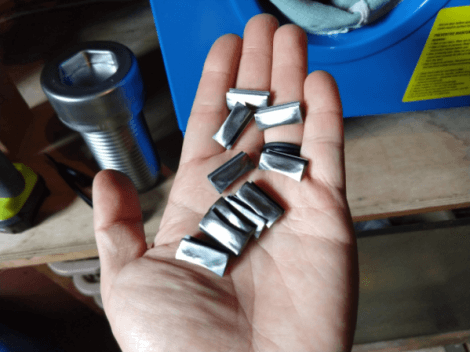
Well, you know full well now that the 3D printer we used, who had promised to help us finish the links, failed and gave up. I chased down an expert polisher from Omega, and he was too scared to try.
I went back to the 3D printer and pushed him to try again. He did. He tried taking the endlinks to another company. Both failed.
I realized I would have to do it myself to figure out how to make it happen. After a some research, I learned that some gunsmiths had success using bullet shell polishing tumblers to finish titanium. So, I purchased a tumbler with much anticipation and poured in some abrasive.
Trial & Error & Error & Error & Victory
From what I read of gunsmiths’ experiences, some said their projects took days of tumbling. Keep in mind, these tumblers are just glorified vibrating bowls.
The thing was ridiculously loud and something came loose and it got even more obnoxious. I worried my neighbors would go out of their mind. I was going out of my mind.
Three days later: FAIL. It did absolutely nothing besides make noise.
Looking back, I don’t know what I was thinking pitting a vibrating bowl against titanium grade 5. Wonderwoman Grace would call it optimism bias.
I set up a DIY mini-grinding cabinet and set to work with my dremel and some flapper wheels. But, when grinding titanium grade 5, because the metal is so hard the grinding produces a lot of heat. So, you need some kind of coolant.
You can’t use water because although it cools somewhat, it wouldn’t lubricate the cutting surface enough to make a difference. And so, I had to use motor oil.
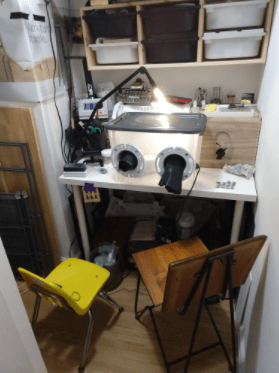
(Scout likes hanging out while I do messy things.)
I dipped the endlink into the motor oil and then applied the dremel flapper wheel. Amazingly, it worked and I was able to grind the nubbly 3D printer textures to a smoother surface.
(And yes, the little DIY cabinet is surprisingly effective because I added an extra sealant in the lid. So, no oil or abrasive dust escaped into the area where I work on watches!)
But still, that surface was not nearly the right match. I need to get matte and smooth.
Maybe the gunsmith vibrating bowl would work now? Nope. I needed a real sand blaster.
Easy-Peasy Sandblast
WRONG. One limiting factor is that I have no room in my workshop in the apartment (a small walk-in closet) for a compressor, so I bought a mini-blaster used for etching glass in the hopes that it could do the job. It was like I was spraying baby powder at the endlink.
With some experimentation, I found what worked fairly well was 220 grit sandpaper. But I couldn’t sand the endlinks like you might imagine, because then I would get a sort of brushed finish.
I found that pressing a fresh part of the sandpaper on the endlink, while rubbing the end of a metal rod against the back of the sandpaper yielded a sort of sandblasted matte finish.
I tried this on a few links and it took hours and my fingers were getting seriously cramped, and the finish was not uniform enough. There was no way I’d get through 30!
Next, I tried various makerspaces and I only found one with a solid industrial sandblasting setup. But they weren’t equipped to let me switch out the abrasive they had preloaded, so I just had to take a shot.
The grit turned out too coarse. I liked the look of it, but it just didn’t match the case and band.
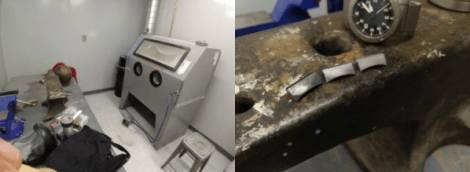
Time & Space
In the end, it took us going to Toronto and a week off from the day job to get them done because there’s no way I could have set this up in our apartment in Manhattan.
Living in a small apartment with two little children (and a very patient wife), and neighbors, it just wasn’t possible to get a large air compressor and real blast cabinet.
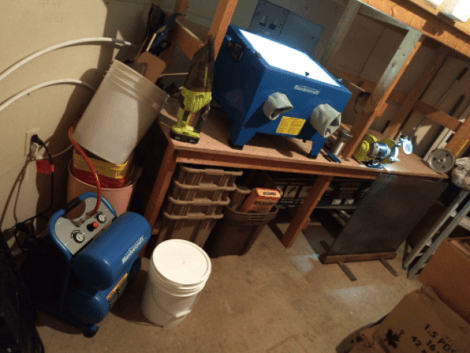
(That’s the final setup that made it happen! We’re now the proud owners of a bench grinder, a blast cabinet, heavy duty air compressor, and 40 lbs of proprietary abrasive mix!)
My plan was to hit the links again with a finer grit. Thankfully, I found a company called Spectrum Abrasives in Toronto specializing in supplying abrasives of all kinds. They’re a family owned business started by the dad, and now run by his two sons.
START OVER

Spectrum explained that I couldn’t reblast a blasted surface. A coarse grit blasted surface, can’t be blasted to an optimal finish with finer grit.
They recommended we use a special grinding wheel first to polish the surface lightly, and then hit the links with a blend of glass and aluminum oxide grit to match the band and case finish as close as possible.
A grandson of the founder, on the way to college in the fall, created the special abrasive blend for us. There’s just something special about a family business.
Here’s a quick 3-step primer for new member registration account creation.
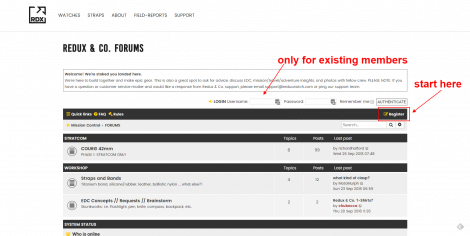

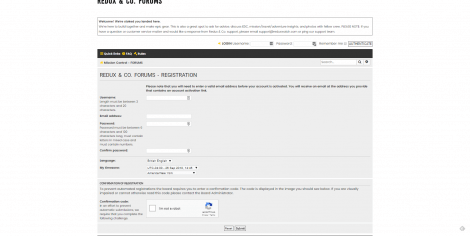
Step 0 / STRAP CHANGE INTEL — ETA. 5 Minutes / COURG / Drilled Lugs
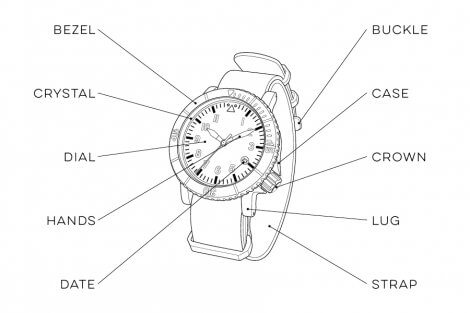
Redux COURG Parts Diagram
Gather components.
(1) 1 or 2 Songs
(1) Beverage
(1) New 2-piece strap
(1) Strap change tool or Macgyver skills
(2) Shoulderless Spring bars
Step 1 / REMOVE EXISTING STRAP
Start your music, sip your drink.
Place your watch face down on a soft cloth on non-scratch surface to protect the crystal and bezel — if you care about things like that. Find the spring bar holes on either side on the outside of the lugs (right next to where the strap connects to the watch). Use the needle end of your strap change tool (or a pin if you’re Macgyver) to push inward to depress the ends of the spring bar inside the lug holes. As you push the tool in, use your other hand to gently slide the strap slightly to release the spring bar from the lug.
*ATTENTION: Don’t tug on the strap too hard or tension on the other end of the spring bar could launch your springbar into a galaxy far far away.
Once both ends are released, slowly slide the strap free of the lugs. Repeat on the other end of the case.
Step 2 / INSTALL NEW STRAP***
Slide spring bars into your new strap so both ends stick out evenly. With the watch upside down, fit one end of the spring bar into one lug hole. Hold the other protruding end of the spring bar against the opposite lug, roughly lined up where the hole is.
Flip the needle point tool end to the flat head side. Pinch the needle point end, pull it out, switch it around so the flat head side faces out. Use the flat head of the strap change tool (or small screwdriver or knife or you get the idea) and push in on the very end of the spring bar so it can slide in between the lugs. Push the bar in against the strap until the end of the spring bar slides down inside the lug. Carefully move the strap up and down until you hear the spring bar click into its hole and ensure a secure fit.
Step 3 / TACKLE YOUR MISSIONS
Strap that watch on with the new strap installed! Then file a field report of your COURG in action.
Checkout the COURG crew gallery: dispatches.reduxwatch.com/gallery — and join us:
Find us @reduxwatch everywhere.
***PLEASE NOTE: Once a strap has been installed and worn (leather creased, dirty, etc.), returns are not permitted on items which can’t go to inventory for resale. So, please ensure the strap will fit before installing.
by Elliot Berkman, University of Oregon and Jordan Miller-Ziegler, University of Oregon
“I love deadlines,” English author Douglas Adams once wrote. “I love the whooshing noise they make as they go by.”
We’ve all had the experience of wanting to get a project done but putting it off for later. Sometimes we wait because we just don’t care enough about the project, but other times we care a lot – and still end up doing something else. I, for one, end up cleaning my house when I have a lot of papers to grade, even though I know I need to grade them.
So why do we procrastinate? Are we built to operate this way at some times? Or is there something wrong with the way we’re approaching work?
These questions are central to my research on goal pursuit, which could offer some clues from neuroscience about why we procrastinate – and how to overcome this tendency.
It all starts with a simple choice between working now on a given project and doing anything else: working on a different project, doing something fun or doing nothing at all.
The decision to work on something is driven by how much we value accomplishing the project in that moment – what psychologists call its subjective value. And procrastination, in psychological terms, is what happens when the value of doing something else outweighs the value of working now.
This way of thinking suggests a simple trick to defeat procrastination: find a way to boost the subjective value of working now, relative to the value of other things. You could increase the value of the project, decrease the value of the distraction, or some combination of the two.
For example, instead of cleaning my house, I might try to focus on why grading is personally important to me. Or I could think about how unpleasant cleaning can actually be – especially when sharing a house with a toddler.
It’s simple advice, but adhering to this strategy can be quite difficult, mainly because there are so many forces that diminish the value of working in the present.
People are not entirely rational in the way they value things. For example, a dollar bill is worth exactly the same today as it is a week from now, but its subjective value – roughly how good it would feel to own a dollar – depends on other factors besides its face value, such as when we receive it.
The tendency for people to devalue money and other goods based on time is called delay discounting. For example, one study showed that, on average, receiving $100 three months from now is worth the same to people as receiving $83 right now. People would rather lose $17 than wait a few months to get a larger reward.
Other factors also influence subjective value, such as how much money someone has recently gained or lost. The key point is that there is not a perfect match between objective value and subjective value.
Delay discounting is a factor in procrastination because the completion of the project happens in the future. Getting something done is a delayed reward, so its value in the present is reduced: the further away the deadline is, the less attractive it seems to work on the project right now.
Studies have repeatedly shown that the tendency to procrastinate closely follows economic models of delay discounting. Furthermore, people who characterize themselves as procrastinators show an exaggerated effect. They discount the value of getting something done ahead of time even more than other people.
One way to increase the value of completing a task is to make the finish line seem closer. For example, vividly imagining a future reward reduces delay discounting.
Not only can completing a project be devalued because it happens in the future, but working on a project can also be unattractive due to the simple fact that work takes effort.
New research supports the idea that mental effort is intrinsically costly; for this reason, people generally choose to work on an easier task rather than a harder task. Furthermore, there are greater subjective costs for work that feels harder (though these costs can be offset by experience with the task at hand).
This leads to the interesting prediction that people would procrastinate more the harder they expect the work to be. That’s because the more effort a task requires, the more someone stands to gain by putting the same amount of effort into something else (a phenomenon economists call opportunity costs). Opportunity costs make working on something that seems hard feels like a loss.
Sure enough, a group of studies shows that people procrastinate more on unpleasant tasks. These results suggest that reducing the pain of working on a project, for example by breaking it down into more familiar and manageable pieces, would be an effective way to reduce procrastination.
When we write that procrastination is a side effect of the way we value things, it frames task completion as a product of motivation, rather than ability.
In other words, you can be really good at something, whether it’s cooking a gourmet meal or writing a story, but if you don’t possess the motivation, or sense of importance, to complete the task, it’ll likely be put off.
It was for this reason that the writer Robert Hanks, in an essay for the London Review of Books, described procrastination as “a failure of appetites.”
The source of this “appetite” can be a bit tricky. But one could argue that, like our (real) appetite for food, it’s something that’s closely intertwined with our daily lives, our culture and our sense of who we are.
So how does one increase the subjective value of a project? A powerful way – one that my graduate students and I have written about in detail – is to connect the project to your self-concept. Our hypothesis is that projects seen as important to a person’s self-concept will hold more subjective value for that person.
It’s for this reason that Hanks also wrote that procrastination seems to stem from a failure to “identify sufficiently with your future self” – in other words, the self for whom the goal is most relevant.
Because people are motivated to maintain a positive self-concept, goals connected closely to one’s sense of self or identity take on much more value.
![]() Connecting the project to more immediate sources of value, such as life goals or core values, can fill the deficit in subjective value that underlies procrastination.
Connecting the project to more immediate sources of value, such as life goals or core values, can fill the deficit in subjective value that underlies procrastination.
Elliot Berkman, Associate Professor of Psychology, University of Oregon and Jordan Miller-Ziegler, PhD Candidate in Psychology, University of Oregon
This article was originally published on The Conversation.
Do you sometimes feel you need a vacation from your vacation?
by Jamie Gruman, University of Guelph
Lots of people will take a vacation this summer, but for many of them, their vacations won’t be the relaxing, recuperative getaways they were hoping for.
Research shows that about 40 per cent of people return from their vacations and feel either no better, or even worse, than before they left.
This happens because many of us make mistakes that compromise how enjoyable and satisfying our vacations can be. Below are some simple recommendations that you can implement before, during and after your vacation that will help ensure that your time off this summer is pleasurable, gratifying and fully recharges your batteries.
Vacations can be stressful. Minimize your stress by planning out key parts of your vacation before you leave.
Reserve a flight outside of rush hour so you don’t get stuck in traffic. Book your scuba diving adventure a few weeks in advance.

Coordinate your decision-making and expectations with travel mates before you leave for vacation. Image: Pixabay
Before leaving make sure that you and your travel partners are clear on everyone’s vacation priorities and have a general agreement about how you’ll spend your time.
While you are away you don’t want to engage in potentially stressful negotiations about how to fill your days. Even a single negative incident on vacation, like an argument with a spouse, reduces how much your time away improves your health and well-being.
A necessary ingredient for recharging your batteries on vacation is mentally disengaging from work. It’s not enough to physically leave the office, you have to mentally leave the office.
This is called psychological detachment. If you’re on the beach constantly looking at your phone to see what’s happening back at work, you’re not psychologically detached. If you check your email three times a day, you’re not psychologically detached.
If you don’t psychologically detach you won’t replenish yourself much on your trip. Turn off the electronics and clear your mind. That said, if you get anxious about the mountain of emails that will be waiting for you when you get back to work, you will also have trouble chilling out. So, engage in email triage.
Once every three or four days, check your email and delete anything you can dispense with immediately. Then, reply quickly to anything that can be addressed with a simple, token response, and mark as unread anything that needs some thought and should be tackled when you get back. This cuts the huge mountain of emails down to a small pile, which will put your mind at ease and allow you to unwind.
Read more:
The importance of actually unplugging on National Day of Unplugging
Be a little bit selfish on vacation and ensure that you get to do what floats your boat. Enjoying yourself is a necessary ingredient in making sure your vacation is recuperative.

Make sure to do things you enjoy.
Vacations are supposed to refresh you and alleviate the burnout you suffer at work, and research shows that when you enjoy yourself and are satisfied with your vacation, your level of burnout drops significantly while away, but when you are not satisfied, your level of burnout barely changes.
Similarly, whether or not you enjoy your vacation strongly affects how refreshed you feel when it’s over. Take time for yourself and participate in activities you find pleasurable and satisfying. This is your vacation. You’ve earned it.
Not everyone has the disposable funds for travel vacations. But that’s OK. Staycations can be as effective as exotic getaways if they are done right.

Staycations can be great. But get out of your routine!
The main mistake people make during vacations at home is that they stay in their normal routine. They cook, they clean, they watch TV. In short, they don’t “vacate” their normal lives.
If you stay at home on your vacation, shake things up. Visit local tourist attractions. Eat different foods. Take day trips to neighbouring communities. Getting out of your normal routine can make a staycation feel as novel and recuperative as an excursion to a foreign land.
Read more:
How to turn your long weekend into a vacation
We usually come back from our travel vacations on Sunday night so we can return to work Monday morning. We do this because we think that maximizing our vacation time means making the vacation last as long as possible.
But the goal of our vacations shouldn’t be to make them as long as possible but to make them as effective as possible. If you return home Sunday night you’re likely to run around trying to hurriedly unpack, water your plants, do laundry, pick up some groceries, check your phone messages and various other things you need to do to get back into the swing of things.
However, scrambling about is stressful and can quickly undo all the health and well-being gains you made while on vacation. Research shows that people who return from vacations a little bit early report being in a better mood for longer than those who return on a Sunday.

Arrive home with enough time to relax and organize before work on Monday morning.
Bookend your vacation with as little stress as possible. Come home early enough to leisurely get back into your normal routine, and ease back into work retaining your vacation benefits for as long as you can.
People often complain that they need a vacation from their vacation. When we return from our time off feeling just as depleted and tired as before we left it is usually because our vacations didn’t allow us to replenish our drained resources, satisfy our needs or adequately disengage from our normal routines.
![]() Implementing a few simple tactics before, during, and after your vacation can ensure that your time off this summer fully recharges your batteries and lets you return to work feeling healthy, happy and productive.
Implementing a few simple tactics before, during, and after your vacation can ensure that your time off this summer fully recharges your batteries and lets you return to work feeling healthy, happy and productive.
Jamie Gruman, Professor of Organizational Behaviour, University of Guelph
This article was originally published on The Conversation.

